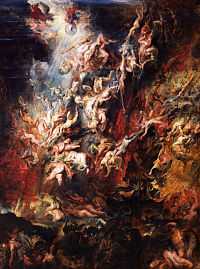The Fall of the Damned
 | |
| Artist | Peter Paul Rubens |
|---|---|
| Year | ca. 1620 |
| Type | Oil on canvas |
| Dimensions | 286.0 cm × 224.0 cm (112.60 in × 88.19 in) |
| Location | Alte Pinakothek, Munich |
The Fall of the Damned, conversely known as The Fall of the Rebel Angels[1] is a monumental religious painting by Peter Paul Rubens. It features a jumble of the bodies of the damned, hurled into abyss by archangel Michael and accompanying angels. David Freedberg assessed this painting manner as the "most brilliant assemblages of lusciously naked flesh in Western art".[2]
In 1959 an art vandal threw an acid on the painting. According to him, he did not directly destroy the work, but the acid "relieves one from the work of destruction".[3]
Sketch
The sketch of The Fall of the Damned was made in black and red chalks, with a grey wash and is kept in the British Museum. It is assumed to be the work of a studio assistant, while Rubens then went over the drawing with brush and oil colour.[4] The dramatic chiaroscuro of the human forms and clouds emphasizes the darkness into which these figures fall, far from the heaven light above.
References
- ↑ "Fall Of The Rebel Angels". Peterpaulrubens.org. Retrieved 2010-11-17.
- ↑ Sophie Perryer, 10 years 100 artists, Struik, 2004
- ↑ "Destructivism". Heyoka Magazine. Retrieved 2010-11-17.
- ↑ "Peter Paul Rubens, drawing for The Fall of the Damned". British Museum. Retrieved 2010-11-17.
